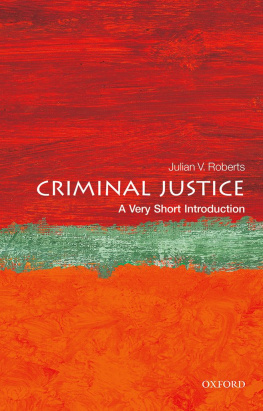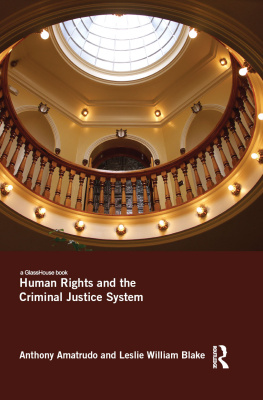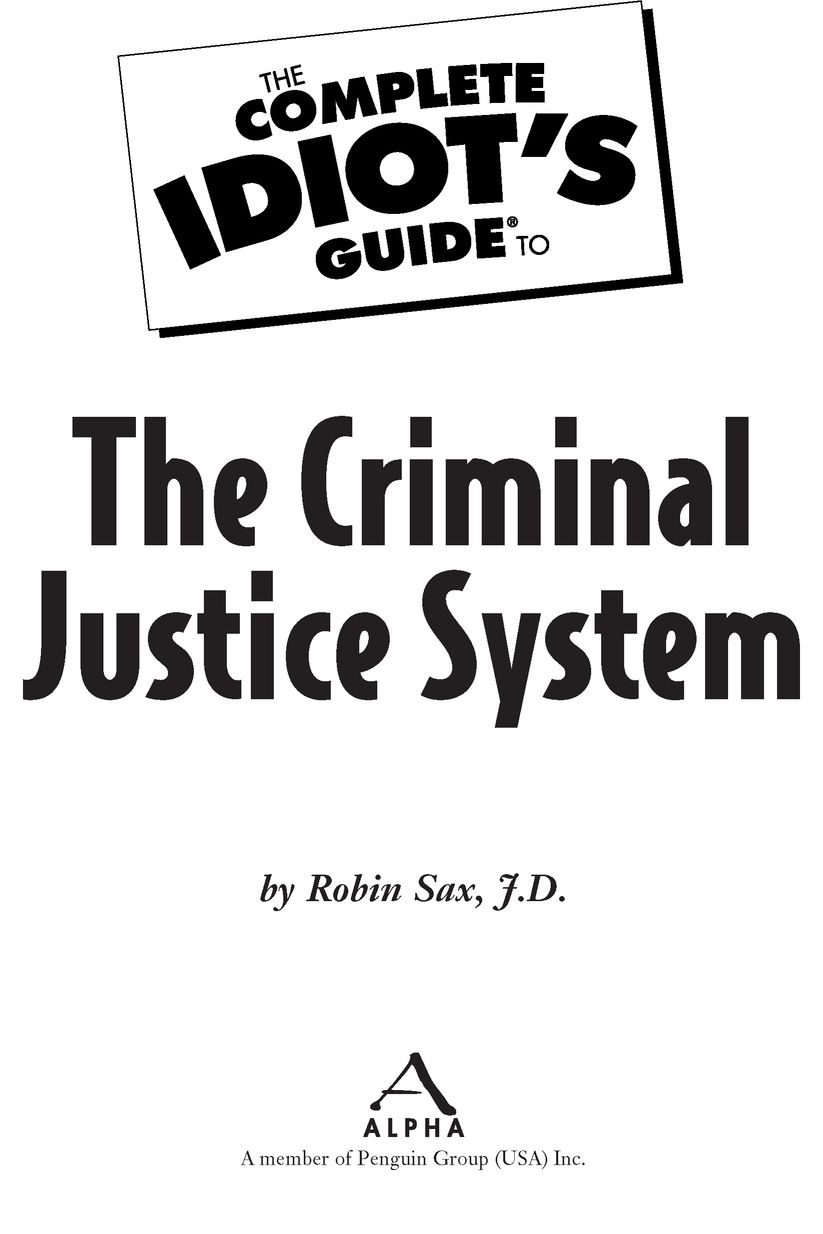Table of Contents
For instilling in me the passion to pursue my dreams and to forge my own path to them,
thank you, Mom and Dad. I love you to pieces.
Introduction
Some people think of the law as boring and tedious, at best, and just a bunch of incomprehensible legalese, at worst. But few would say that about criminal law. Just review the nightly TV listings: crimeand its investigation and prosecutionhas a gut-level, real-life drama that captures the interest and hearts of nonlawyers and lawyers alike.
TV crime shows are entertaining, but their ability to educate is iffyat least, if you want a comprehensive understanding of the criminal justice system. Thats where this book comes in. In the following pages, I give you an insiders view of the whole systemnot with the arcane detail of a textbook, but rather focusing on whats important, whats useful, and what you need to know to understand how the system really works.
Well look over the shoulders of the police as they investigate a crime, find out why and when they get search and arrest warrants, and find out why they always give those Miranda warnings to a suspect. Well discuss the elements of different crimes: youll learn the difference between larceny and burglary; what makes a killing manslaughter, second-degree murder, or first-degree murder; and why it matters so much whether the prosecutor decides to charge a misdemeanor or a felony.
After the defendant is charged, the trial begins. Well cover the actual trial process, from bail to jail. Well walk through how a case makes its way into court; discuss the roles of judge, jury, and all those other people in the courtroom; and examine the defendants constitutional rights, the victims bill of rights, and everything in between. And of course, well talk about sentencing.
But one thing this book wont do is make a lawyer out of you, or serve as a substitute for one. The United States has 52 different court systems (the 50 states, the federal courts, and the District of Columbia), and each has its own laws and procedures. Throughout the book, I strive to give you a general or consensus view, but I cant cover all the variations in procedures, codes, and laws of all the different court systems. Those differences, and the individual details of each defendants case, matter a lotand so this book cannot and should not be considered legal advice.
Heres a quick roadmap of how Ive organized this book:
Part 1, The Criminal Justice System and Its Classifications of Crime, is the foundation for everything else to come. This is where I cover the difference between civil and criminal law, the relationship between state and federal crimes, and why some cases go to state courts and some to federal courts.
Perhaps the most important purpose of Part 1 is to explain why the criminal justice system is in placewhat it is trying to accomplish, who it is trying to protect, and how it does this. Part 1 also gives the basics about how crimes are defined and the different classifications of crimes, which will prove useful as we move into the discussion of specific crimes in Part 2.
Part 2, Elements of Specific Crimes, is the nuts and bolts of the acts we know as crimes. We take each one apart, inspecting its elements in the context of the real world. The best way I know to help you understand these elements is to draw on my own experience as a prosecutor, so youll see lots of examples as we go through these elements.
Part 2 covers all the well-established crimes, including murder, rape, and burglary. But it also covers more modern crimes, like stalking, identity theft, and elder abuse. We cover the gamut.
Part 3, From Crime to Trial, starts with the wail of a police siren in the night.
A crime has been committed, and this part takes you through the investigation, the limits on the police as they search for evidence, and whats required for an arrest. This is also where I cover the charging processhow a case gets filed, what makes a case not get filed, who decides what crime to charge, and all the steps once an investigation becomes an official criminal case.
Part 3 also explains the rights of the accused during and after the investigation, from the Miranda rule, to fair line-ups, to the right to a lawyer. It also covers the major defenses available to a person accused of a crime, such as insanity, self-defense, and entrapment.
In Part 4, The Trial Process, we step into the courtroom. I introduce the whole courtroom cast, arraignment, bail, preliminary hearings, and jury selection. I outline each stage of the criminal prosecution and discuss the options available to prosecutors, defendants, and judges. A courtroom can be a scary place, especially when everyone but you seems to know exactly what is going on. Part 4 demystifies the process, showing you the method to the madness and revealing its roots in our U.S. Constitution.
Part 4 also gives you a firm grounding in the rules about what does and doesnt get admitted into evidence. But we dig a bit deeper than just the rules and get into why the various rules, like hearsay and privilege, are there in the first place. We close Part 4 with the juryhow the judge instructs jurors in the law, how they deliberate, what happens when they have questions, and of course, their verdict.
Part 5, The Post-Trial Criminal Justice System, brings us full-circle as we re-examine the purposes of criminal law and how they affect sentencing and punishment. The job of the criminal justice system doesnt end with the jurys verdict. The entire system would be rendered meaningless if there were no consequences for convicted defendants or recourse for victims. This section reviews the range of sentencing possibilities available, both traditional and creative, from probation to prison, to the death penalty.
Part 5 also takes a look at the juvenile justice system. It covers why we have one, whos a juvenile, what the differences are from the adult system, and why some juveniles are tried as adultsalong with a lot else.
Part 5 closes the book where it should, with a very important but sometimes overlooked topic: the rights of victims. It examines the victims right to be informed about their case, to be present at trial and other proceedings, and to be heard. I share with you one of the most moving victim impact statements Ive ever heard, and discuss how and why these statements are used. Victim restitution, which means reimbursement for damages a crime has caused, is also covered, as are witness-protection programs.
Throughout this book, you will see the following special features:
For the Record
These give you an insiders view of the system, its players, and how it all really works.
Objection
Here youll find red flags, pitfalls, and other things to look out for in the criminal justice system.
definition
These sidebars define and explain the legalese and other specialized terminology that can interfere with even the most bril liant persons understanding of what is going on.







